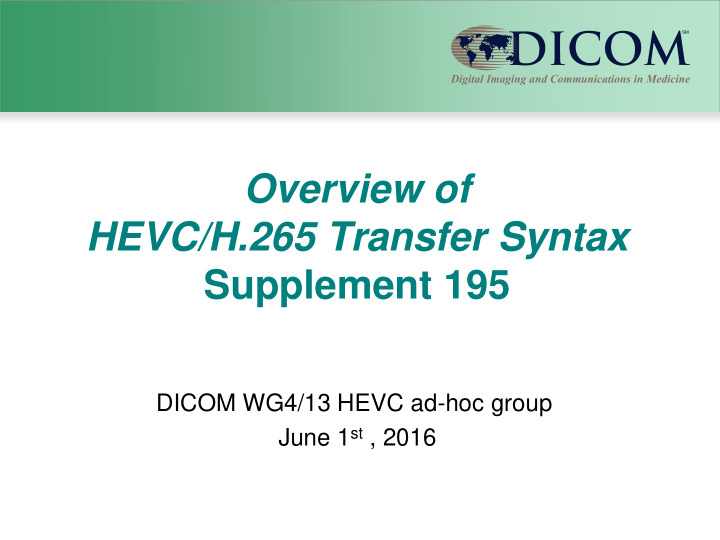



Overview of HEVC/H.265 Transfer Syntax Supplement 195 DICOM WG4/13 HEVC ad-hoc group June 1 st , 2016
Video coding standards history • MPEG-2 (1994): Standardized in DICOM in 2004 Compression ratio o Supplement #40 to MPEG-2 4 • MPEG-4/AVC (2003): Standardized in DICOM in 2010 o Supplement #149 and #180 2 1 • HEVC (2013): Proposed for standardization into DICOM MPEG-2 AVC HEVC today High Efficiency Video Coding Transfer Syntax 2
Domain of application • Encode single or multi-frame video content • Can be used instead of AVC or MPEG-2 • Should be used to compress the size of DICOM video data • For compression of video of up to 4k resolution and frame rate of 60fps • Main 10 profile usable for HDR and WGC content High Efficiency Video Coding Transfer Syntax 3
Needs for HEVC • Smartphones compatibility o HEVC content is already created o As of now, need transcoding to be used in DICOM • Higher compression efficiency o For optimized usage of server space and network bandwidth High Efficiency Video Coding Transfer Syntax 4
Differences between AVC and HEVC • More efficient o Doubled compression rate • More complex o Supported by off the shelf hardware and software • Compression artifacts less obvious o Less “ blockiness ” High Efficiency Video Coding Transfer Syntax 5
Proposed HEVC profiles • HEVC has one profile per type of video • Supplement 195 proposes support for 2 profiles: o HEVC Main profile with level 5.1 • 4:2:0 content • Up to 8 bit depth o HEVC Main 10 profile with level 5.1 • 4:2:0 content • Up to 10 bit depth o Both for videos with up to 4k resolution at 60fps High Efficiency Video Coding Transfer Syntax 6
Proposed standardization • No new SOP Classes or IODs • Addenda to 6 parts of DICOM • 2 new transfer syntaxes o HEVC Main profile o HEVC Main 10 profile • Essentially similar to AVC transfer syntaxes o Support for audio stream to be encompassed High Efficiency Video Coding Transfer Syntax 7
Availability of HEVC codecs • Market is already set up for HEVC 4:2:0 chips • New smartphones already support HEVC High Efficiency Video Coding Transfer Syntax 8
Licensing issues (1/2) • Fujitsu has no patent pertaining to the inclusion of HEVC inside DICOM • HEVC is associated to 2 patent pools known to the Editor of this supplement. No claims to the comprehensiveness of the following list. This is not intended as legal advice: • 1) MPEG-LA patent pool: o http://www.mpegla.com/main/programs/HEVC/Documents/HEVCw eb.pdf o Licensing fee only for hardware/software o Not per stream High Efficiency Video Coding Transfer Syntax 9
Licensing issues (2/2) • 2) HEVC Advance o http://www.hevcadvance.com/pdf/RoyaltyRatesSummary.pdf o New patent pool // Controversial and criticized o Payment per stream IF stream is sold or rented to a customer High Efficiency Video Coding Transfer Syntax 10
Fragmenting HEVC streams • Should we loosen the constraint concerning fragmenting? o Do we enforce the need for a key frame at the beginning of a fragment? • This group recommends to loosen the constraint • Keep one DICOM object per stream o Limits to 2^31-1 maximum frames (19884 hours at 30fps) High Efficiency Video Coding Transfer Syntax 11
Next Steps • Checking the proposed supplement sanity • Publishing the supplement for public comment High Efficiency Video Coding Transfer Syntax 12
Recommend
More recommend